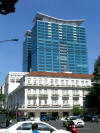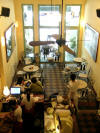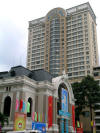Round The World and other travels
A frequent flyer's collection of trip diaries
This is: Vietnam 2010
Asian sights, French cuisine
I woke up around 0730, which was probably a little later than intended, but absolutely nothing to worry about. Breakfast was in the Executive Lounge, which had a nice range of offerings but again was far too busy for its size. We set out shortly after 0930 to make our way to the morning's main objective, the Reunification Palace. We passed a number of well-known buildings en route, including the Opera House, the Continental and Caravelle hotels, and Notre Dame cathedral.
Once again, I was fascinated by the street life
and by the incessant motorbike traffic. Motorbikes are by far the
most popular method of transport in Vietnam yet, despite their
ubiquity, they can easily take you by surprise, for example by going
the wrong way down a one-way street. I had to put the previous day's
lesson on road-crossing into practice many times over and on one
occasion, when I must have looked a bit hesitant, a local woman said
to me in English: "slow and steady!" Once I got the hang of it, it
all flowed - in Bruce's words - like a carefully choreographed
ballet. I felt sure that the only reason it stood any chance of
working was because the average speed of the traffic was low by
western standards. The overall situation was perfectly summed up by
a section in Bruce's guide book headed Traffic Rules and Safety,
the content of which consisted of two words: dream on!
![]()
We soon arrived at the Reunification Palace, managed to side-step the hawkers stationed outside (despite much pressing of chilled coconuts and water bottles against our arms), bought our entrance tickets and were able to join an English-speaking tour immediately. The current building was erected in the early 1960s as a direct replacement for its beautiful French colonial predecessor, which was bombed by two dissident air force pilots in 1962. The replacement building started life as the Independence Palace and it also played a key role in more recent Vietnamese history, when in 1975 a North Vietnamese tank crashed through the main gate, marking the end of the Vietnam War. Today's visitors find a structure that is instantly recognisable as a product of the sixties, at least to those of us who were around at the time. The tour took us round the various chambers and war rooms.
A film in the basement afterwards provided a chance to sit down and relax, while listening to much propaganda and an inevitably one-sided account of the war, with America portrayed as a foreign aggressor rather than a supporter of one half of a divided people. One particular propaganda song, featuring the oft-repeated words 'Vietnam, Ho Chi Minh', was quite literally a recurring theme and as I heard it for the umpteenth time, I knew that it was going to be near-impossible to erase it from my memory. I daresay these things are put together with precisely that intent! Once outside again, we found that the grounds were now quiet, as the entrance gate was closed over lunchtime. We saw the North Vietnam jets that bombed the palace in 1975, in an attempt to make history repeat itself, and a couple of tanks.
With the temporary closure to new visitors reminding us of the time of day, we exited the grounds, ran the gauntlet of the hawkers (who, in fairness, were pleasant enough) and made our way the short distance to the nearby restaurant Au Parc, a French bistro with Moroccan decor. We were shown to a first-floor table, and it was a blessing just to get out of the sun once again. I had a delicious light lunch of a Gorgonzola, pear and walnut sandwich, a refreshing beer and a naughty Earl Grey-flavoured crème brûlée.
Nourished and rested, we were ready to walk the relatively short distance to the afternoon's main objective, the War Remnants Museum. The military hardware was out at the front and, as we were having a look and taking photos, a man began to speak to us. He made to shake hands, except that there was no hand or forearm there, and I found myself giving the gentlest of squeezes on his stump. It was the first of what would turn out to be many graphic reminders of what war really means. The building housed some explicit displays, including alarming pictures of deformities and disfigurements and, worst of all, some stillborn and deformed foetuses that had been victims of the toxic defoliant Agent Orange. Despite the horrific nature of much of the subject matter, there were numerous examples of spectacularly good photography.
This very sobering visit at an end, we walked back to the Caravelle Hotel and I found myself yet again fascinated by the traffic. The skies were beginning to look a little threatening, but it was still dry as we rode the elevator to the 9th floor and found the excellent Saigon Saigon bar. It was a really nice place and, remarkably, seemed to be a few degrees cooler than at street level. We enjoyed a refreshing Campari & soda on the terrace, enjoying the view of the Opera House and the main shopping street, Dong Khoi.
 Back
at the hotel, we freshened up, took in Happy Hour at the Executive
Lounge and then went for dinner at the nearby French restaurant
La Fourchette, which looked as though it had come straight out
of Paris. Bruce had kidneys with mustard sauce, while I had a most
enjoyable rabbit-based dish, all of this accompanied by a nice rosé
wine. It was a great ending to a busy day, one in which I felt that
I was really starting to get to know this place a little better.
Back
at the hotel, we freshened up, took in Happy Hour at the Executive
Lounge and then went for dinner at the nearby French restaurant
La Fourchette, which looked as though it had come straight out
of Paris. Bruce had kidneys with mustard sauce, while I had a most
enjoyable rabbit-based dish, all of this accompanied by a nice rosé
wine. It was a great ending to a busy day, one in which I felt that
I was really starting to get to know this place a little better.





























